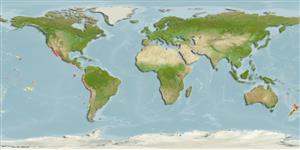Common names from other countries
Classification / Names / Names
ชื่อสามัญ | ชื่อพ้อง | Catalog of Fishes (gen., sp.) | ITIS | CoL | WoRMS
Environment: milieu / climate zone / depth range / distribution range
นิเวศวิทยา
; ระดับความลึก 0 - 180 m (Ref. 865). Tropical; 35°N - 24°N, 121°W - 109°W
Eastern Central Pacific: USA to Mexico.
Length at first maturity / ขนาด / น้ำหนัก / Age
Maturity: Lm ? range ? - ? cm Max length : 7.5 cm CW เพศผู้/กระเทย; (Ref. 865)
Benthic. Exists in front (Ref. 121701), in highly productive upwelling areas, often transported as far as 1000 miles offshore (Ref. 121700). Found in the shelf (Ref. 121703), partially or fully buried in sand and swims on the surface. It inhabits low intertidal areas to a depth of 180 meters (Ref. 865). Also found in estuaries (Ref. 121701). Associated with coral reef ground (Ref. 121702).
Life cycle and mating behavior
วัยเจริญพันธุ์ | การสืบพันธุ์ | การวางไข่ | เซลสืบพันธ์ของเพศเมีย(ไข่) | ความดกของไข่ | ตัวอ่อน
Members of the order Decapoda are mostly gonochoric. Mating behavior: Precopulatory courtship ritual is common (through olfactory and tactile cues); usually indirect sperm transfer.
Gotshall, D.W. 2005. (Ref. 865)
IUCN Red List Status (Ref. 130435)
CITES status (Ref. 108899)
Not Evaluated
Not Evaluated
Human uses
การประมง: การค้า
| FishSource |
เครื่องมือ
ข้อมูลเพิ่มเติม
Age/Size
การเจริญเติบโต
Length-weight
Length-length
สัณฐานวิทยา
ตัวอ่อน
อุดมสมบรูณ์
แหล่งที่มาจากอินเตอร์เน็ต
Estimates based on models
Preferred temperature
(Ref.
115969): 10.4 - 26.9, mean 18.5 (based on 138 cells).
